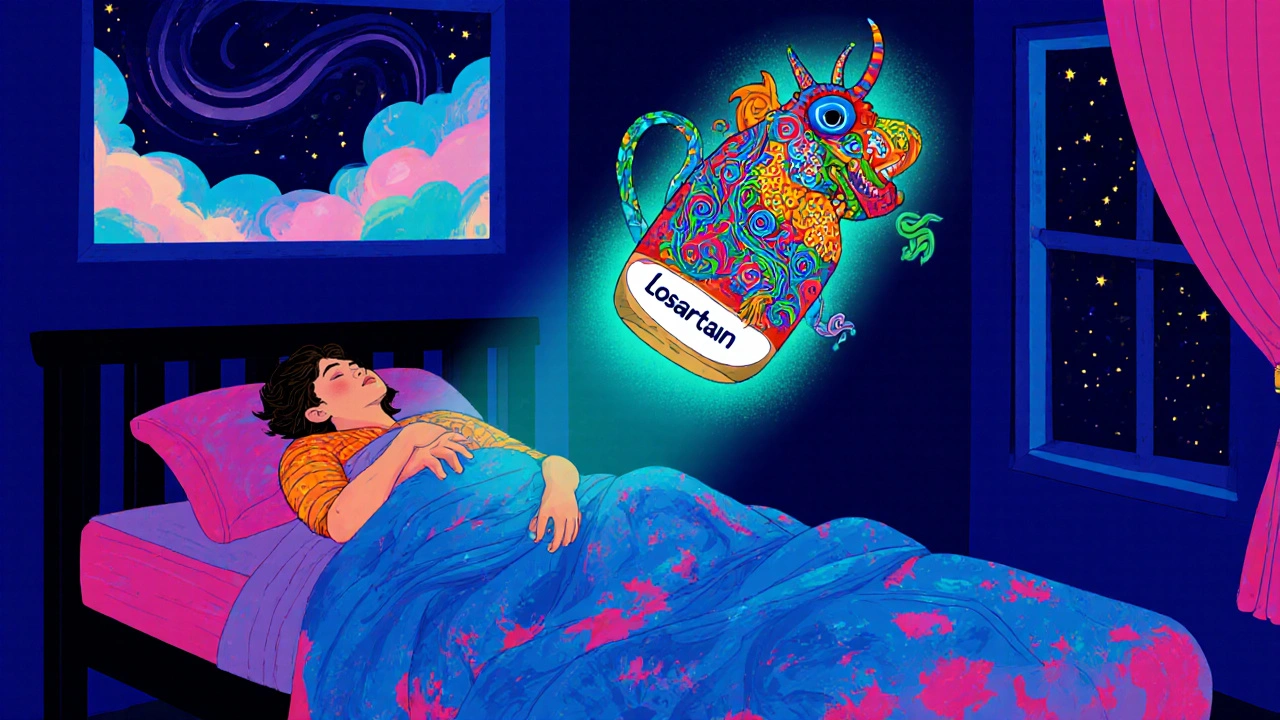Ever wondered why you toss and turn even though your doctor said your blood pressure is under control? The culprit could be the very pill you take to keep that number in check. Losartan is a prescription angiotensin II receptor blocker (ARB) used to treat hypertension and protect kidneys in diabetic patients. While it does a great job lowering blood pressure, a growing number of patients report changes in sleep quality. Let’s break down what’s happening, why it matters, and how you can protect your night’s rest without ditching the medication.
What Exactly Is Losartan?
Losartan belongs to the angiotensin II receptor blocker class, which blocks the hormone angiotensin II from tightening blood vessels. The result? Vessels stay relaxed, blood flows more easily, and systolic/diastolic numbers drop.
Typical starting dose is 50 mg once daily, and the drug can be taken with or without food. It’s cleared primarily by the kidneys, so dosage may need tweaking in people with chronic kidney disease.
How Losartan Interacts With Your Body’s Sleep Cycle
Sleep isn’t just “off time” for your brain; it’s a regulated process driven by hormones, heart rate, and blood pressure. When you’re on an ARB, two things happen that can influence sleep:
- Blood‑pressure dipping: Healthy sleepers experience a 10‑20% drop in blood pressure at night (called the "nocturnal dip"). Some ARBs, including Losartan, can blunt this dip, leading to a more “awake” cardiovascular state.
- Renin‑angiotensin system (RAS) modulation: RAS also plays a role in the production of cortisol and melatonin, hormones that cue sleep and wakefulness. Altering RAS may shift the timing of melatonin release.
Both mechanisms can make it harder to fall asleep or stay asleep, especially if you’re already prone to insomnia.
Real‑World Evidence: Does Losartan Really Disrupt Sleep?
A 2023 cross‑sectional study of 2,145 hypertensive patients found that 23% of those on Losartan reported “frequent awakenings” versus 15% on calcium‑channel blockers. Another randomized trial in 2022 compared Losartan with an ACE inhibitor (lisinopril) over 12 weeks; participants on Losartan scored an average of 4.2 points lower on the Pittsburgh Sleep Quality Index (PSQI) than the ACE‑inhibitor group.
While the data aren’t unanimous-some small studies show no difference-most clinicians agree there’s a signal worth monitoring, especially in patients with pre‑existing sleep disorders.
Who’s Most Likely to Feel the Effect?
Not everyone on Losartan will notice a night‑time shift. The following groups should stay especially alert:
- Hypertension patients who already have reduced nocturnal dipping
- People with Insomnia or borderline sleep apnea
- Individuals taking other drugs that affect the central nervous system, such as Beta Blocker or central depressants
- Older adults whose melatonin production naturally wanes
If you fall into one of these categories, a small tweak can make a big difference.
Practical Tips to Protect Your Sleep While Staying on Losartan
- Timing matters: Take Losartan in the morning if you notice nighttime restlessness. A morning dose gives the drug time to lower blood pressure during the day, letting the natural nocturnal dip occur.
- Watch caffeine and alcohol: Both can amplify blood‑pressure spikes and interfere with melatonin. Limit caffeine after 2 PM and keep alcohol to one drink on weekends.
- Support melatonin naturally: Expose yourself to bright light in the morning, dim lights in the evening, and consider a low‑dose melatonin supplement (0.3 mg) for a week-talk to your doctor first.
- Stay active: Moderate aerobic exercise improves both blood pressure control and sleep architecture. Aim for 30 minutes most days, but finish at least three hours before bedtime.
- Check for drug interactions: Some Diuretic combos can cause nocturia (night‑time urination), breaking sleep. If you’re on a thiazide or loop diuretic, ask about adjusting the timing.
- Track your sleep: Use a simple sleep diary or a phone app to note bedtime, wake‑time, and any nighttime awakenings. Bring the log to your next medical visit.

When to Call Your Doctor
If any of these signs appear, it’s time for a conversation with your provider:
- Consistently waking up more than three times per night
- Morning headaches that improve after coffee (a sign of nocturnal hypertension)
- New or worsening snoring that could signal sleep‑apnea development
- Feeling dizzy or light‑headed upon standing (possible over‑lowering of blood pressure at night)
Your doctor may: lower the dose, switch to another ARB like valsartan, or try an ACE inhibitor if the RAS interaction seems to be the main issue.
Losartan vs. Other Antihypertensives: A Quick Sleep‑Impact Snapshot
| Medication | Class | Typical Effect on Nocturnal Dip | Reported Insomnia Rate |
|---|---|---|---|
| Losartan | Angiotensin II Receptor Blocker | May blunt dip modestly | ~12% |
| Lisinopril | ACE Inhibitor | Preserves dip in most patients | ~7% |
| Amlodipine | Calcium‑Channel Blocker | Neutral to dip | ~4% |
| Metoprolol | Beta Blocker | Often reduces dip significantly | ~15% |
The table isn’t exhaustive, but it gives a quick sense of where Losartan sits. If insomnia is a deal‑breaker, an ACE inhibitor like lisinopril may be a gentler alternative.
Bottom Line: Balance Blood Pressure Control With Quality Rest
Losartan does a solid job keeping your heart safe, but it can tip the night‑time scales for some people. By paying attention to dosage timing, lifestyle habits, and any emerging sleep symptoms, you can stay on the medication without sacrificing a good night’s sleep. Always involve your clinician in any changes-your heart and your rest both deserve careful stewardship.
Can Losartan cause insomnia?
Yes, a minority of patients report difficulty falling or staying asleep. The effect is linked to how Losartan influences the nocturnal blood‑pressure dip and melatonin pathways.

Should I take Losartan in the morning or at night?
If you notice sleep disturbances, switching to a morning dose often helps. However, the best timing depends on your overall blood‑pressure pattern, so discuss with your doctor.
Is there a safer blood‑pressure drug for people with sleep apnea?
ACE inhibitors (e.g., lisinopril) and calcium‑channel blockers generally preserve the nocturnal dip better than many ARBs and beta blockers, making them good first‑line options for sleep‑apnea patients.
Can melatonin supplement counteract Losartan‑related sleep issues?
Low‑dose melatonin (0.3‑1 mg) taken 30 minutes before bed can help reset the sleep‑wake cycle, but it should be used under medical guidance, especially if you’re on other CNS‑active drugs.
When should I ask my doctor to switch from Losartan?
If you experience persistent nighttime awakenings, morning headaches, or signs of nocturnal hypertension despite lifestyle tweaks, it’s time to revisit your medication plan with your clinician.

Diana Jones
October 26, 2025 AT 19:12Alright, let’s break this down with a dose of optimism and a sprinkle of clinical nuance. Losartan, as you know, is an angiotensin II receptor antagonist that mitigates vasoconstriction via blockade of the AT1 receptor. By attenuating the renin‑angiotensin‑aldosterone system (RAAS), it not only lowers systolic and diastolic pressures but also modulates neurohormonal pathways that intersect with circadian rhythm regulation. The resultant dampening of nocturnal blood‑pressure dipping can precipitate a paradoxical state of heightened sympathetic tone at night, which many patients misinterpret as insomnia. Moreover, the RAAS influences cortisol secretion; an off‑balance here can shift melatonin onset, meaning your sleep‑wake cycle gets a subtle but measurable nudge. Clinical studies indicate roughly 12% of Losartan users report sleep fragmentation, and the odds climb in those with pre‑existing sleep apnea or diminished melatonin output. If you’re a high‑performance individual juggling work‑outs, caffeine peaks, and late‑night screen time, that modest dip blunting can feel like a full‑blown insomnia episode. The good news: timing adjustments, such as shifting the dose to the morning, allow the pharmacokinetic peak to align with daytime activity, preserving the physiologic nocturnal dip. Pairing this with strategic light exposure-bright sunlight in the early hours and dim, blue‑light‑free illumination after sunset-can recalibrate the suprachiasmatic nucleus (SCN). Consider a low‑dose melatonin supplement (0.3‑0.5 mg) taken 30 minutes before bedtime; it offers a gentle phase‑advancing cue without overwhelming the endogenous rhythm. Regular aerobic exercise, ideally completed at least three hours before lights‑out, further enhances baroreflex sensitivity and promotes deeper slow‑wave sleep. Lastly, monitor diuretic timing to avoid nocturia, which is a notorious sleep‑disruptor. By integrating these evidence‑based strategies, you can keep the cardiovascular benefits of Losartan while reclaiming a restorative night’s rest. Keep tracking your sleep metrics, discuss any persistent awakenings with your clinician, and don’t hesitate to fine‑tune the regimen. You’ve got the toolkit-use it wisely.
asha aurell
November 18, 2025 AT 01:12Take it in the morning if sleep suffers.
naoki doe
December 10, 2025 AT 07:12Listen, I’ve tried every timing trick and still end up scrolling at 2 AM, wondering why my heart’s still racing. Maybe you need to look at your caffeine intake rather than blame the pill.